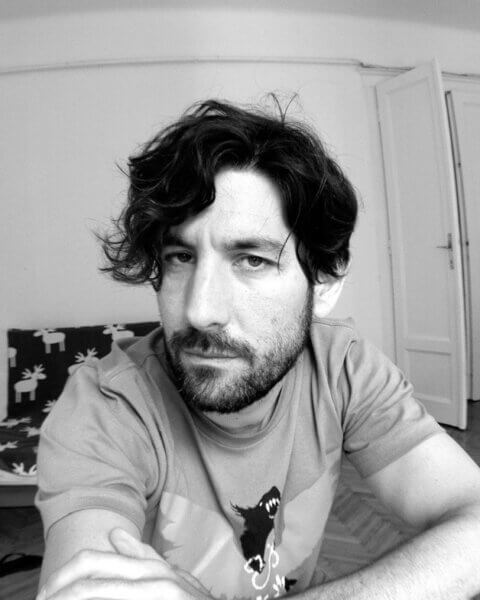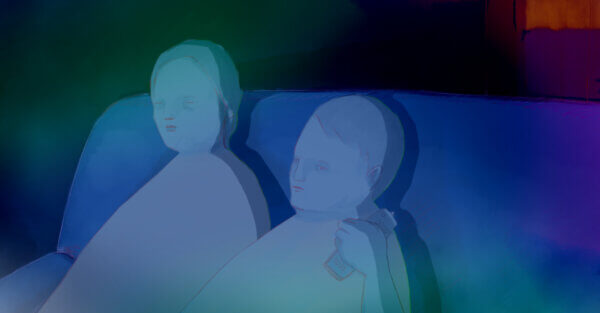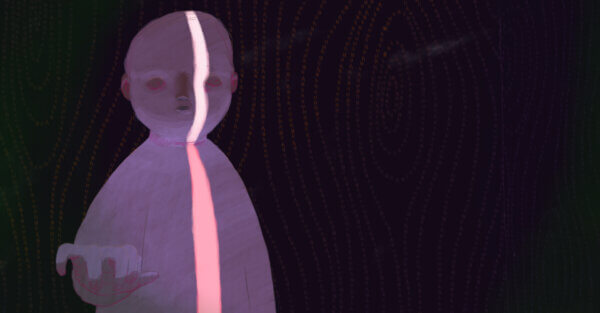Interview with ‘HIDE’ director Daniel Gray
UPDATE 17/04/2023 – Daniel Gray’s HIDE is now available to watch online in full (stream below)
Having studied animation at the University of Wales in Newport, Daniel Gray’s graduation short t.o.m. (co-directed with Tom Brown, a creative partnership that would continue for over a decade as Holbrooks Films) made an enormous impact during its festival run, scooping up awards at Annecy, Ottawa International Animation Festival, Fantoche, the British Animation Awards, the Royal Television Society Awards and the London International Animation Festival among others – as well as receiving a Cartoon d’Or nomination and an Honorable Mention at Sundance.
The duo achieved similar success with their 2015 short film teeth – an at-times nightmarish, yet strangely hypnotic, animated memoir of a man obsessed with constructing a ‘perfect’ set of replacement teeth from across the animal kingdom – which would go on to screen at over forty festivals as well as winning the FIPRESCI Prize at Annecy and another pair of double-wins at the BAAs and RTS Awards.
In the years since Holbrooks have parted ways – at least for the time being – with this week seeing the international premiere of Daniel’s solo short film outing HIDE, produced by La Cellule Productions, CUB Animation and the National Film Board of Canada. Boasting the familiar, ethereal, painterly quality of Daniel’s prior work and breeding a similarly compelling sense of unease throughout, HIDE depicts a young boy who, while playing hide-and-seek, is unexpectedly confronted with visions of an increasingly-alienating future.
Presently based in Hungary where he works and lives with his family, Daniel took some time to catch up with Skwigly about his new project and the journey to get it made.
We last spoke to you back in 2016 when your previous film teeth was released online. What have you been up to between then and HIDE?
I had HIDE written when teeth was in the festival loop; between then and now it’s been HIDE most of the time. I wrote a few other things, freelance things of course. In general, though, HIDE.
Having previously been part of the two-man operation Holbrooks, HIDE represents your first outing as a solo short film director. Did this offer up any perks or challenges as a new experience?
That’s not really something I can answer. Best interviewee ever, I am. What I mean is, I can’t compare the two experiences. When I was working with young Tom Brown, we were working between schedules, in our spare time, with no funding. So everything was a lot harder. On this occasion, I was working with great producers at CUB, La Cellule and the NFB, and was able to work on the project almost full-time.

Daniel Gray
Does the premise of HIDE, which sees a child passively (fearfully?) watching time pass with increasing rapidity from an ostensibly neutral hiding place, have any particular personal origin?
The child starts the game hiding with excitement and joy, but he becomes more apprehensive as the experience becomes less escapable and grim. The origin is me trying to describe a feeling of homesickness I have. It’s the modern version, where you chat and see everyone digitally every day; and the feeling of being apart is more hidden and harder to pinpoint. But it’s there. The digital versions you see of your family and friends are more often than not the edited highlights. Everyone is happy, only good things are passed on. No one is ill. But then when I physically visit home (I live in Hungary but I’m from Wales), everything is different. People seem conspicuously older. People have died. Stuff is different. So I’m trying to make a study of that feeling; trying to manifest it in an audience.
Can you talk us through the journey it took for HIDE to get funded and ultimately made?
Weeeeeell, a top tip for anyone taking a film to festivals is to have your next film available, in some form or other, to show. When a producer asks you what you’re working on next, you can say, “This!” And give them a paper or send them an e-mail. That’s the job, and that’s what they’re asking when they say, “What’s next?” So I had HIDE with me when teeth was in festivals; I met with Maral [Mohamaddian] from the NFB, who liked the project. CUB came on board too, and they found La Cellule. Then they each roped in resources from their respective territories. I spent a month doing the backgrounds and setups at the Abbaye Fontevraud, then I spent two months at Ciclic with a team of four animators, and overlapping that, the colouring was being done. I did the comping and stuff, then we had the sound design done by Olivier Calvert in Canada. Then they did all the post with remote connections and all kinds of technical wizardry.

HIDE (La Cellule Productions, CUB Animation, The National Film Board of Canada)
Had you worked with CUB and/or La Cellule before this project, and similarly were there any particular areas of production they took the lead on?
I’ve worked with CUB a fair amount by freelancing on some of their shorts and their commercial projects. They’ve been involved in some great shorts over the last few years. I’d never worked with La Cellule before; they were suggested to CUB and we met them. We really liked their energy and passion for their projects, so we decided to work together then.
The scenario HIDE depicts could be open to multiple interpretations, although for me there’s a particular personal resonance as regards feeling increasingly detached from the people and locales I grew up with as I get older. Was the film conceived with a particular interpretation in mind or was it more based around the visual concept?
It was overmuch based on the story I’d written first, which was about my feelings of homesickness. I don’t like to be too literal with what I do and prefer to try to evoke a shared feeling in an audience. This does mean that there can be other interpretations of it, but I think they’ll all have the common feelings of disconnection and longing, and that peculiar feeling in your stomach.
While there’s a distinct quality to the film’s design style the main character definitely brings t.o.m. to mind, while the elaborate painterly approach to the colours and lighting is quite evocative of teeth. Was this a conscious pairing?
It’s just the way I draw, I think. I love light and volume. I love composition and how the weights and gravities of colours interact. I think the visual style is a result of these things. When I started the project, it took me a while to remember how I, as one person, draw and design a final image. I’d been working as a partnership on that stage for a long time, so I went through a few mental grinders trying to remember how I draw. I’d done a music video for Hauschka that was very useful for me getting myself together in that way. Short answer: no.
On top of the surrealism of the main concept, said lighting as well as the overall approach to the sound and framing of each shot gives the film a very palpable sense of unease throughout – while not outright horror it feels genuinely unsettling and claustrophobic at times. Is this rooted in anything in particular?
It’s the contrast between finding the best place ever to hide, and the box you now find yourself in. It’s a device to bring the audience together through the unease that builds throughout the film. From the fun innocent game to the claustrophobic trap/void that comes with the rapid passing of time.

HIDE (La Cellule Productions, CUB Animation, The National Film Board of Canada)
Moving forward do you imagine you’ll continue to direct solo or go back to being part of a team/duo?
I’m open to anything, really. I think Tom and I will probably end up working together at some point in the future. I see designers who I’d love to work with. I’d love to make something longer and more ambitious too, and that tends to come from collaboration.
The film sees its premiere at the prestigious OIAF – have you been involved with this event before and are you looking forward the film’s festival journey being kicked off?
I’ve had two films and a commissioned short screened there before. t.o.m. won the graduation film award back in the day, but I’ve never been there. It’s in my bucket list of festivals to visit as I only ever hear good things about it, but I think they’ve done the right thing taking it online—and they’re doing a great job of it. I particularly like that the shorts selections have been broken up into shorter blocks. If I’m being honest, it’s not the way I’d envisioned the film’s journey out into the big world; I’d designed the look from inside the cupboard with a giant dark cinema in mind. But these are interesting times—and it’s still Ottawa!
As with all films out this year, it is premiering under the unusual and compromised circumstances of a digital festival landscape. From your perspective as a filmmaker and festival vet how do you feel festivals have been adapting to the current crisis?
I think in general, festivals are doing what they think is right. There’s no rule book to follow here, that I’m aware of, at least. For me, I’m going to roll with it. I’d love to see HIDE in a cinema with an audience at some point, though.
What’s next for you?
I’m working on another short. I wrote it last year, I think. Now that HIDE is done, I’ve time. There’s a storyboard and a scratch VO, and I’ll play around with the boardomatic. I’ll do that, freelance. I’ll see how people react to HIDE and whether it brings any opportunities my way.
Hear more from Daniel Gray on HIDE in our Skwigly at CAF 2022 podcast minisode. See more of the work of Daniel Gray on his Vimeo channel.

